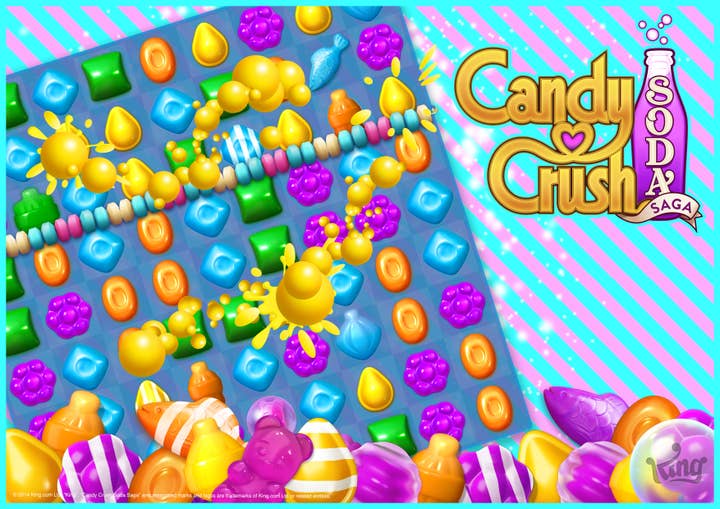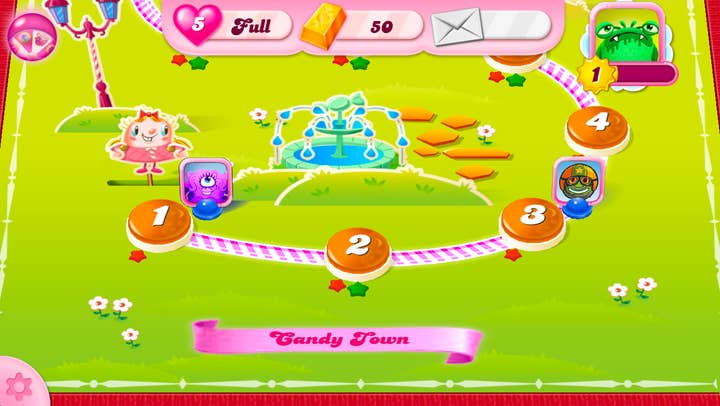An introduction to UX writing for mobile
King's Patricia Gómez Jurado shares good practices around crafting user experience copy for casual mobile games
Mobile gaming revenue represented an estimated 49% of the global games market in 2020.
That's a pie valued at $86.3 billion that everyone wants a slice of. But like with any dominant market, it inevitably means that actual success is strenuous, with new studios popping up every day without necessarily having the expertise required.
Quality is an issue that affects all corners of the industry. As games development tools get increasingly accessible, more and more titles emerge, some of them barely meeting the criteria of a minimum viable product.
Everyone can be a mobile developer but delivering a quality game that finds its audience is something else entirely. Small teams will tend to wear multiple hats without realising that the devil's in the details.

One such detail is UX, and more particularly UX writing, which revolves around creating helpful and understandable copy that guides the user throughout the game experience. It's particularly crucial for mobile gaming as players typically want an experience that has as little friction as possible.
And that is exactly the aim of Patricia Gómez Jurado, associate director of content design at King. She leads the mobile company's UX writing teams from its Barcelona office.
"My team basically designs experiences through words, and writes micro-copy for UI components such as onboardings, [calls to action], error messages and so on, for our main games in the Candy Crush franchise," she explains.
UX writers -- which King sometimes refers to as 'content designers' -- work in close partnership with UX and game designers, as well as UI artists, to deliver clear, brief and useful copy. Having a good UX writer can make the difference between someone playing your game for hours, and someone abandoning it from the tutorial because the goal is unclear.
If you're only just starting your development journey, Patricia Gómez Jurado has advice to share about the dos and dont's of UX writing for casual games on mobile.
Hire a specialist
Her first piece of advice is a straightforward one: hire someone specifically to cater to your UX writing needs. Before King created its content design division in 2020, micro-copy was written by the games designers themselves.
"The thing is that they did not have the right skills -- their skills were around game design and some of them were not English native speakers," Gómez Jurado says. "So what happened is that the localisation team had to review the copy in English before sending the content for translation. And they changed that when we introduced this content design craft, and now we are creating good quality micro-copy from the beginning."
If you can't afford hiring a specialist, she recommends attending courses on UX writing or read resources. She suggests three books in particular:
- "Strategic Writing for UX: Drive Engagement, Conversion, and Retention with Every Word", by Torrey Podmajersky
- "Writing Is Designing: Words and the User Experience", by Andy Welfle and Michael J. Metts
- "Content Design", by Sarah Winters (written under the name Sarah Richards)
"A good quality for a UX writer is how they can collaborate with other crafts and put the player at the heart of what they do"
"Everyone in the studio can learn about content design," Gómez Jurado continues. "It's a topic that is drawing more and more attention because in the end it's about the player experience, and how to communicate to players in a way that is clear and delightful."
A good UX writer will have excellent communication skills, empathy, and good writing chops, she adds.
"A good quality for a UX writer is how they can collaborate with other crafts and put the player at the heart of what they do. When I started setting up the content design craft I think the first thing that I did was reach out to the related crafts and we brainstormed on how we wanted to work together, just to make sure that we were aligned and we knew from one another who does what in order to spot any gaps or overlaps. Cross functional collaboration is super, super important to the work we do."

Take into account the specificities of playing on mobile
Mobile is a platform that has very specific needs, and those needs should inform both your design and UX writing decisions.
"We apply the same content design methodology that we would apply in desktop, but in mobile what we need to take into account is that the players' behaviours and uses are different," Gómez Jurado says. "When using a mobile device people interact [with it] in a different way than [when] using a laptop or a PC.
"They also use it at different times of the day or in different places. For example, players may use a laptop for work during the day and then in the evening they come to our games to relax. They might be playing on their way to work. The context of playing is key to help you design the experience.
"And in relation specifically to content, one of the main differences is the limited app space. When you are designing or writing for a desktop experience you have a lot more space, and when you are designing or writing for mobile devices, you need to be super clear, concise and useful because that's limited app space out there."
Keep the player's mental load in mind
King's ethos for UX writing, as you might have understood it by now, is that the copy needs to be clear, concise and useful.
The result needs to flow naturally, and be almost invisible. UX writing is one of these jobs that will be almost unnoticeable if done well -- like audio design, for instance. Players would notice if the audio of a game was all over the place, but more often than not, the work of the audio designer is barely noticeable to the end user. The same applies to UX writing: if the user notices it, it's usually not going to be for good reasons.
"In casual games specifically, we need to make sure or help the player lower their mental load"
"In casual games specifically, we need to make sure or help the player lower their mental load," Gómez Jurado says. "Because of the context they are playing in, they may not have their full attention into the game, so we need to make sure that when they're reading the text they basically don't need to think much to actually understand what they need to do. People come to our games to have fun so they shouldn't spend any time worrying about how the interaction works or what the message means, because all they want is just play.
"When we think about designing an interaction -- looking at both the words and the visuals -- the idea or the goal will be that the players do not perceive the interaction, so that this actually comes to them like it is really natural. This will mean that we did a really good job."
When writing calls to action, for example, the copy needs to be extremely clear, and use words that actually describe that action, again to help players alleviate their mental load. The same applies to error messages, which need to clearly explain what the next step is.
"When presenting error messages to players, because sometimes things might go wrong or the internet connection is off, we need to explain what happened and what the solution is, so that the player doesn't feel [stuck] and they know how they can move on," Gómez Jurado continues.
"And when we talk about creating a copy that is clear, concise and useful I will also add one word, which is human. Because we cannot forget that we are writing for an interface that needs to communicate with a human being, so we also need to make sure that there's this human touch that is present."

Work closely with your localisation team
Mobile is a global market, so if you're working on a title for iOS or Android, chances are you're aiming for territories outside your own country. Localisation is crucial to a successful launch in other markets and your UX writing team should collaborate with your localisation team -- whether in-house or outsourced -- as closely as possible.
"Normally, we do UX writing in English and then we'll localise the English content into our other languages," Gómez Jurado says. "And this is why collaboration between the UX writing craft and the localisation team is so important, on different levels.
"Localisation can help UX writing, raising issues [if] there's some part of the design that might be interpreted in a different way depending on the country"
"On one level, it's for us to make sure that translators get enough context and information about the new feature that we're launching. Not only about the [writing] but also about the visuals -- how it's going to look. Especially because most of the translators may work from home or work as freelancers in an outsourcing company, so they may not have full access to all the information that we have at King.
"UX writers can also help translators by adding information like character limitations, since we are working on a mobile device and the space is limited -- at least for translators to know or to have a guidance of how many characters they have maximum for a given string.
"And on the other hand, localisation can help UX writing, bringing a cultural input, raising issues in case there's some part of the design that might be interpreted in a different way depending on the country. When you think of colours, they may have a different meaning depending on the market as well. So there's many areas where these two teams can collaborate so that the user experience can feel local. We want to avoid creating a user experience that is just for English speaking players. We want to make sure that this is as engaging for other players who speak other languages as well."

Track and learn from your players' behaviours
Finally, it's worth remembering that mobile is a very data and analytics-driven market. We have explored these topics at length on the GamesIndustry.biz Academy, from how to split and analyse your players, to growing your game through user acquisition, or how to balance data and creativity.
Tracking and learning from your players' behaviours has become essential to being a successful mobile developer -- and that applies to UX writing as well.
"The first thing that we need to learn about our players is the language that they use, how they [interact with] our games or features, and how they understand the micro-copy," Gómez Jurado says. "It is very important that we use a language that players can understand and they can identify as well. One thing to remember is that we are not our users. So, this is why we need to listen and observe them, to learn from them."
"We are not our users. This is why we need to listen and observe them, to learn from them"
To learn from its players in the context of UX, King uses two strategies: player interviews and collaboration with customer support. The former can easily be put in place through Discord or any community-facing platform, while the latter is an easy step that boils down to analysing the feedback given by players or the issues they encounter.
"We collaborate a lot with [King's UX research] team by attending player interviews or watch them after, and actually see how our players interact with our games, if they're using any specific words or expressions, and see whether they are understanding the feature that they have in front of them.
"Customer support is also a great source [of insight], especially in our community, through emails when they contact us. It's a goldmine of insights when looking and reading comments from them. A few months ago we were contacted by the players support team because they observed a spike in contacts -- over 50% of the incoming tickets were related to a new feature that the Candy Crush Friends team launched. And we actually looked at the micro-copy to understand what were the issues and [worked with] them on how to improve the understanding of the interface for players."
If you're after raw data that you can analyse, A/B testing is another invaluable tool.
"A/B testing is really good for gathering quantitative data," Gómez Jurado continues. "If you have two versions of the same feature and you want to test which micro-copy is more impactful or players interact with more or better, you may want to launch an A/B test.
"[Whereas] players interviews are useful to gather qualitative insight, and get an initial idea on understanding how our players feel about the feature or about the game. We use a player interviews to empathise with the player and understand how they see and perceive our product."

